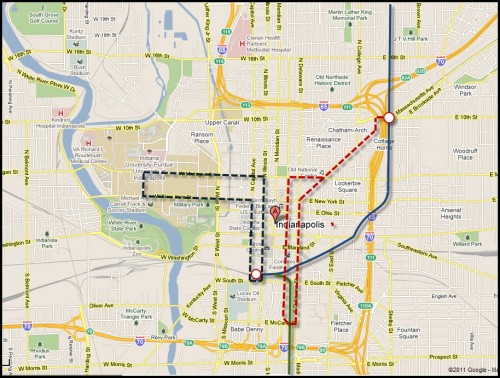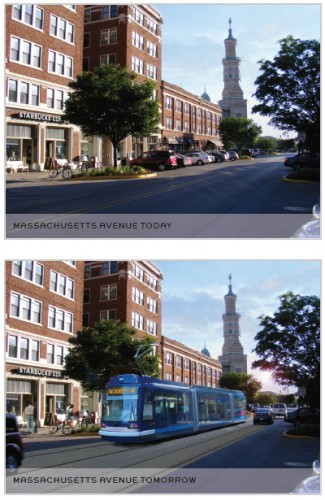So it is now early April and the bickering over social issues has reached a fever pitch in the Indiana legislature. There has been a little bit of news in the local media regarding proposed cuts to mass transit funding from the state totally nearly 18% which would deal a critical blow to transit agencies all around the state. Efforts are underway to prevent this from happening.

Accordingly, there has been no real public movement on the Indyc0nnect proposal. While lawmakers try to wrangle a way to get a dedicated funding source via public referendum, the discussions continue regarding just what the transit plan will look like. There is no time better than the present to dig in to what the planners have proposed for the downtown streets of Indianapolis. For the purposes of this examination, I am limiting this to the high profile projects such as rail and bus rapid transit offerings. The details in this post are from the MPO’s Long Range Transit Vision Document and represent the best that I can make of what they describe. I do not think the map I have sketched is THE idea, but it seems to be close.
The first and highest profile project will be the NE Corridor rail line (dark solid blue on map). This would be the first passenger rail service in decades and primarily serve northeast side suburban commuters from the Fisher area as well as anyone along the route through Marion County who may be able to take advantage. Service frequency is TBDÂ however, 15 minute peak headways and 30 minute off-peak headways have been announced in the document. By the time the NE Corridor line is put into service, Union Station would also be on the downside of an estimated $100 million makeover that would create a more passenger friendly facility that is well equiped to handle the NE & S corridor rail lines. I have written about what this might look like prior.
The second project to come online, would be the South Corridor commuter rail route (dark solid green on map). The other significant happening that would be coordinated with the South Corridor’s opening would be the relocation of frieght trains that currently use lines that snake through the core of the DT area. These trains would be routed to the belt line that passes south of the downtown area. We have also written about that project here at Urban Indy.

The next two projects of note are BRT circulators that would aid in transporting people that last mile from the commuter routes to various job and education centers around the downtown area. The first of these that would come on line would service the IUPUI campus and connect with Union Station (dashed dark blue on map). The second would utilize Mass Ave and connect commuters from a proposed 10th street rail station on the NE Corridor and travel to the Eli Lilly campus on the SE side of downtown (dashed red on map). While I have advocated strongly against the proposed BRT lines throughout the region based upon the notion that they do not spur development, these BRT lines seem to make a lot of sense to me. The routs would service activity centers around downtown and offer frequent service that would serve to move people the last mile to their destination; a large problem in the transit world. Furthermore, the planners have already hinted that these could become future streetcar or light rail lines which would further serve to invigorate the sections of downtown that they would travel through.
These projects represent some exciting possibilities. Moreover, if advocates such as myself have our way, we would ask for one or both of these BRT circulator routes to be tabbed as rail lines to begin with. Additionally, a full blown zoning plan to accompany the NE corridor and S corridor rail lines that would detail specific dense land use policies would be implimented. Overarching all of those suggestions would be route changes. However, that seems a tougher obstacle to overcome given currently planned upon funding hurdles. These are the aggressive ideas that we should be seeking for the Indyconnect plan to salvage what has become a comparatively watered down transit plan.
It is still my belief that the suburban commuter lines simply escalate the price for commuters who chose to live far away to do the same thing they are doing now. Why should we devote a majority of transit funding to encourage residents to move to Fishers or Noblesville? The service limits of transit should be urban in nature. Promote proximity and infill. This will be a drain and a negative press article for transit in Indy about negative ROI. Believe me, I understand the external benefits of commuter rail and the potential of TOD’s, but it isn’t the culture of this area and hasn’t been for 70 years. We don’t have the urban residential center that will encourage poeple to locate close. What is to prevent people from simply moving even further out towards Anderson or something of that nature and then driving to the park n ride to ride the train. I suppose I am concerned with what the ultimate goal we envision is. I voiced my concern to ICAT of paying for poeple to commute and was told that ‘any rail is good rail and will be progress’. That comment haunts me still. We need to think long and hard about serious comprehensive land use reform before we put lines on a map. I am a supporter of rail as much as anyone here, but more importantly I am a supporter for effective transit as it relates to proximity and urban form. I hate to say it, but with the ultimate goal of a spoke and hub commuter system for $2 Billion I will vote no.
I agree with you totally. Getting the people pulling the levers of this plan to understand that has become a large focus of mine. Seeing comments like yours are valuable in helping with that message.
I agree with Joe and have been saying the same thing since the IndyConnect plan was revised to remove the Washington Street light rail while it kept Fishers commuter rail.
.
I’ll vote no on a referendum for any plan that puts suburban rail first. I do not believe that “any rail is better than no rail”. I believe that light rail or streetcar (north-south and east-west lines that meet Downtown) should be the core of the Marion County public transit system, and that the regional system should be built on that base.
Suburban commuter rail would be detrimental to our local economy because it’s not practical…at least for the next 50-70 years. To make everyone happy (historic preservationists, tourists/conventionors, environmentalists, architects and land planners, small business owners, Lilly, and most importantly existing and future downtown/Midtown residents) Indianapolis needs to remember the streetcars and trains which graced our streets back in the days. It’s time to connect the Inner neighborhoods with downtown, with that being the #1 AND ONLY PRIORITY.
Amelia Miller (of ICAT) has this to say. For some reason, she cannot post to the site. Not sure what the problem is….
——————————————–
Curt – Thanks again for your coverage of this important issue! Efforts are indeed underway to prevent the cut to the PMTF. The amendment failed in the House, but there is still time to contact senators and request support for reinstatement of funding in the budget bill. As far as the NE corridor is concerned, I want to note that the Marion County Alliance of Neighborhood Associations (MCANA), which represents neighborhood groups all along the corridor (and within the city proper) is an active member of ICAT and speaks regularly with neighbors that support the plan because of the benefits it promises their communities – in terms of TOD, increased property values and access to other parts of the city.Joe – I’m not sure what the context was surrounding the response you received from ICAT, but I want to assure you that our position is more nuanced than was represented to you. That said, we do believe that we have to start somewhere. Although this issue is just now (finally) getting some attention from the general public, advocates have been working towards this start for DECADES. Given the options of implementing an imperfect plan now that we can improve upon in coming years through continued education and advocacy (and demonstrating local support for transit that will allow us to leverage the federal funding necessary for a system that is truly supported long-term), or doing nothing and waiting around twenty or thirty more years to begin building a multi-modal and comprehensive transportation network in central Indiana, we would absolutely choose to do something and therefore support the Indy Connect plan.
I encourage you to attend one of our meetings if this is an issue you care about (held the first Thursday of each month from 4:30-6pm at rotating locations). We would love to have your perspectives represented and for you to better understand our position and the work we do.
Amelia Miller
ICAT Chair
http://www.indianacat.org
my intent was not to slander all of ICAT or consider them short-sighted. My positions is that after waiting for decades, we finally have some momentum. It scares the crap out of me that we are chosing to build an enourmous loss leader to benefit few in high positions where it is politically more stable. This NE line will have little chance at any quick gains and may take decades to produce the promised postive benefits with no regional zoning policies. This area was built for the car. People located there knowing the commute they face and to this day they still do. We have spent billions on 465/69 “upgrades” to ease their choice of commute and still we find traffic. This plan wants to place a billion dollar system to allow people to locate further out of the core and have their commute subsidized further. The charge that would need to accompany this system for them would counteract any realized savings. This project WILL be a black eye if it is the first project selected. My fear is that we work so hard for so long to get this going and we chose the least feasible route to hang our hats on. A serious revision is in order and we must reprioritize our locations. Focus on the city. Move people around town, not in and out again. Make indy a 24 hour community instead of a daytime workplace with small side shows at night.